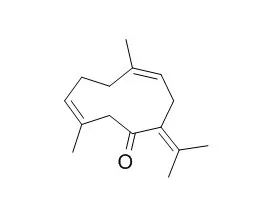| Kinase Assay: |
| Mol Med Rep. 2014 Aug;10(2):1046-50. | | Germacrone inhibits the proliferation of glioma cells by promoting apoptosis and inducing cell cycle arrest.[Pubmed: 24889088] | Germacrone is one of the major bioactive components of the traditional Chinese Medicinal plant Curcuma aromatica Salisb. and has been shown to possess anti‑tumor properties.
METHODS AND RESULTS:
In the present study, the anti‑proliferative effect of Germacrone on human glioma cells and the molecular mechanism underlying its cytotoxicity were investigated. Treatment of the U87 and U251 human glioma cell lines with Germacrone inhibited the cell proliferation in a dose‑ and time‑dependent manner as assessed by MTT assay, while significantly lower effects were observed on normal human astrocytes. Flow cytometric analysis and DNA fragmentation revealed that Germacrone promoted apoptosis of glioma cells, associated with an increased expression of p53 and bax and decreased expression of bcl‑2. Furthermore, flow cytometric cell cycle analysis revealed that Germacrone induced G1 phase arrest, associated with an obvious decrease in the expression of cyclin D1 and CDK2 and an increased expression of p21.
CONCLUSIONS:
In conclusion, the present study suggested that Germacrone may be a novel potent chemopreventive drug candidate for gliomas via regulating the expression of proteins associated with apoptosis and G1 cell cycle arrest. | | J Huazhong Univ Sci Technolog Med Sci. 2013 Jun;33(3):339-45. | | Germacrone induces apoptosis in human hepatoma HepG2 cells through inhibition of the JAK2/STAT3 signalling pathway.[Pubmed: 23771657] | Previous studies have shown that STAT3 plays a vital role in the genesis and progression of cancer. In this study, we investigated the relationship between the JAK2/STAT3 signalling pathway and Germacrone-induced apoptosis in HepG2 cells.
METHODS AND RESULTS:
HepG2 cells were incubated with Germacrone for 24 h, the protein expression of p-STAT3, STAT3, p-JAK2 and JAK2 was detected by Western Blotting, and RT-PCR was used to determine the expression of STAT3, p53, Bcl-2 and Bax at transcriptional levels. Besides that, HepG2 cells were pre-treated with AG490 or IL-6 for 2 h, and then incubated with Germacrone for 24 h. The expression of p-JAK2, JAK2, p-STAT3, STAT3, p53, Bax and Bcl-2 was detected by Western blotting. The activity of HepG2 cells was tested by MTT assay. The apoptosis of HepG2 cells and levels of reactive oxygen species (ROS) were flow cytometrically measured. The results showed that Germacrone exposure decreased p-STAT3 and p-JAK2 and regulated expression of p53 and Bcl-2 family members at the same time. Moreover, IL-6 enhanced the activation of the JAK2/STAT3 signalling pathway and therefore attenuated the Germacrone-induced apoptosis. Suppression of JAK2/STAT3 signalling pathway by AG490, an inhibitor of JAK2, resulted in apoptosis and an increase in ROS in response to Germacrone exposure.
CONCLUSIONS:
We therefore conclude that Germacrone induces apoptosis through the JAK2/STAT3 signalling pathway. | | Toxicol In Vitro. 2013 Sep;27(6):2005-12. | | Interactions of sesquiterpenes zederone and germacrone with the human cytochrome P450 system.[Pubmed: 23850985] | Misclassification of Curcuma species (family Zingiberaceae) may lead to unwanted human exposure to Curcuma elata sesquiterpenes zederone and Germacrone which have caused hepatotoxicity and changes in CYP expression in laboratory animals. We investigated how these compounds interact with the human cytochrome P450 (CYP) system, in order to evaluate their potential for human liver toxicity and herb-drug interactions.
METHODS AND RESULTS:
We found that both sesquiterpenes (1-30 μM) greatly induced expression of CYP2B6 and CYP3A4 but not CYP1A2 mRNAs in human primary hepatocytes (HPHs). This induction profile correlated with activation of constitutive androstane and pregnane X receptors. Cytotoxicity was also observed in exposed HPHs. CYP inhibition studies with pooled human liver microsomes (HLMs) indicated that zederone and Germacrone moderately inhibited CYP2B6 and CYP3A4 activities in vitro, with IC50 values below 10 μM. When zederone was incubated with HLMs and NADPH, one di-epoxide metabolite was formed and by using glutathione trapping, five epoxide-derived conjugates were detected. Germacrone produced two oxidized metabolites and four glutathione conjugates.
CONCLUSIONS:
The results suggest that enzymes in HLMs convert sesquiterpenes into reactive, electrophilic compounds which may be causative for the reported liver injuries. These findings provide insight on the safety and drug-herb interactions of the Curcuma species. |
|






 Cell. 2018 Jan 11;172(1-2):249-261.e12. doi: 10.1016/j.cell.2017.12.019.IF=36.216(2019)
Cell. 2018 Jan 11;172(1-2):249-261.e12. doi: 10.1016/j.cell.2017.12.019.IF=36.216(2019) Cell Metab. 2020 Mar 3;31(3):534-548.e5. doi: 10.1016/j.cmet.2020.01.002.IF=22.415(2019)
Cell Metab. 2020 Mar 3;31(3):534-548.e5. doi: 10.1016/j.cmet.2020.01.002.IF=22.415(2019) Mol Cell. 2017 Nov 16;68(4):673-685.e6. doi: 10.1016/j.molcel.2017.10.022.IF=14.548(2019)
Mol Cell. 2017 Nov 16;68(4):673-685.e6. doi: 10.1016/j.molcel.2017.10.022.IF=14.548(2019)